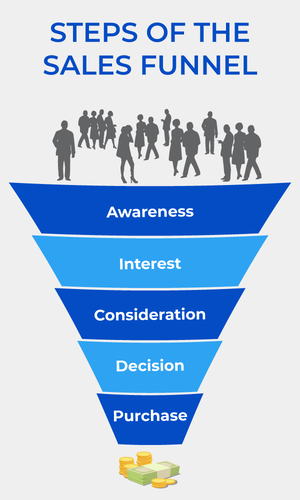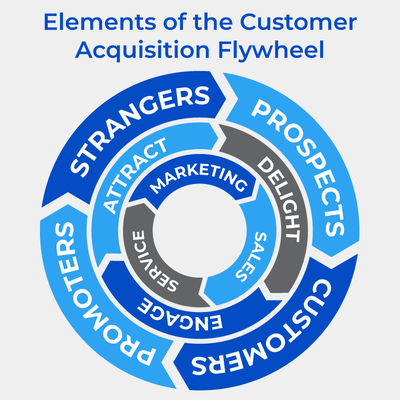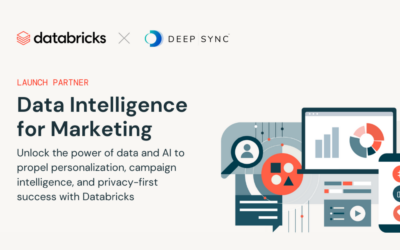Nevertheless, the challenge of growing your business is often not a lack of potential customers. Instead, the challenge generally lies in deciding the best tactics to use to determine and reach your target audience.
Among these approaches, acquisition marketing is an effective and trusted way to continue to reach and capture new audiences. In this guide, we’ll review the basics of acquisition marketing, plus the best practices for implementing this approach:
- What Is Acquisition Marketing?
- What Is Customer Acquisition?
- 4 Important Channels for Acquisition Marketing
- 4 Ways to Improve Your Acquisition Marketing Strategy
Of course, you want to make the most efficient and effective use of your limited time and resources. If you decide to pursue acquisition marketing for your business, consider working with a data partner that specializes in developing and implementing acquisition marketing strategies. These agencies can save you time and effort and help you see the greatest ROI with this marketing approach.

What Is Acquisition Marketing?
Acquisition marketing is the process of using promotional and advertising techniques to bring new customers to your business. Compared to other forms of marketing, acquisition marketing targets ideal prospects who may or may not have already shown an interest in your company and are considering purchasing your products or services.
This type of marketing, sometimes called prospect marketing, takes a step beyond generating general brand awareness and visibility to focus on converting interested leads into paying customers.
Odds are the average visitor to your website won’t make a purchase right away. You likely have a huge number of already interested leads that—with the proper attention—you can turn into long-term customers.
In this sense, the development of an acquisition marketing strategy is crucial to capturing these lost leads—and ultimately to the success of your business. However, to pinpoint the role of acquisition marketing in your company’s marketing strategy, we must consider its place in the larger customer acquisition cycle.
What Is Customer Acquisition?
Customer acquisition encompasses the entire journey customers take with a business, from awareness to making a purchase. From capturing a lead’s attention to processing their payment, customer acquisition is what keeps a business growing and turning a profit.
Of course, we all want loyal customers to act as dedicated brand ambassadors. But, how do we get there? Across most industries, we can look to both traditional and new marketing models to describe typical customer behavior.
Sales Funnel vs. Flywheel
Customer acquisition is often thought of in the context of two complementary models: the sales funnel and the sales flywheel. In this section, we’ll review the focus of each model and the ways they can work together to orient your acquisition marketing strategy.
Sales Funnel
The sales funnel is one of the most popular, well-known marketing models. The sales funnel describes the steps customers take from initial awareness of your business to eventually making a purchase.

The sales funnel model envisions the business-customer relationship as a linear one:
- Top of Funnel: At the top of the funnel, a customer may not even recognize that they are looking for a product or service to solve a problem—or even the exact problem they’re hoping to solve. For example, a customer at the top of the sales funnel for a data hygiene provider might start by searching: “Why is my email deliverability so low?” During this phase, customers become aware of their problem and possible solutions.
- Middle of Funnel: At the middle of the funnel, customers evaluate and compare relevant brands and products. For example, after some research, the same customer with low email deliverability might decide they need a data hygiene solution and compare the relevant providers that claim to meet their needs. Here, at the interest and consideration stages of the funnel, acquisition marketing strategy enters the picture—helping you convince a lead that your product or service is their best option.
- Bottom of Funnel: Finally, at the bottom of the funnel, a lead decides on the specific product or service they want (yours, if you did your job right!) and completes a purchase.
However, the sales funnel represents only a part of the customer acquisition equation. To get a more complete picture, we must also look at the flywheel model.
Sales Flywheel
Some marketing professionals promote the idea of a sales flywheel in addition to the sales funnel. The sales flywheel is a marketing model that places customers at the center of a constantly moving cycle—one that prioritizes the role of customer service and word-of-mouth referrals in acquiring new and repeat customers.
Thus, the flywheel model depicts an ongoing process of engaging customers, delighting them with what you have to offer, and earning their support.

Both the sales funnel and the sales flywheel can help us visualize and predict the behavior of the average consumer. The sales funnel is a useful way to think about the customer cycle of a single sale. However, when we want to look at the full, extended life of customer engagement, the cyclical nature of the flywheel can make for a more accurate trajectory.
Customer Acquisition Cost and Customer Lifetime Value
If we think of sales in terms of the flywheel model, a customer acquisition strategy is only as effective as its ability to retain existing customers.
While the customer acquisition cost is the total amount of money your business spends on bringing in a new customer, this metric only accounts for the initial expenses of bringing a new customer on board, including your acquisition marketing expenses: paid ads, consultant fees, content creator costs, and so on.
For this reason, a business will often look at customer acquisition cost in the context of their “customer lifetime value.” Customer lifetime value is the total profit that a business earns from each customer over the course of their relationship. Generally speaking, the longer a business retains its customers, the lesser the impact of the initial customer acquisition cost.
To ensure your customer acquisition cost stays at a reasonable level, assess the return on investment (ROI) of each of your acquisition marketing platforms. When done effectively, acquisition marketing contributes to better quality leads; this, in turn, will boost your customer lifetime value. In the next section, we’ll explore and assess the most important acquisition marketing platforms to consider.
4 Important Channels for Acquisition Marketing
You can pursue a variety of organic and paid strategies across channels to implement your acquisition marketing strategy. To decide where to focus your efforts, you’ll want to consider your available marketing resources, the products you’re selling, and your target audience.
Today, this will most likely take place in both digital and physical spaces, including social media, email, direct mail, and your website:
Social Media
Today, 5.52 billion people are active users on at least one social media platform. Ignoring the reach and influence of these sites equates to sabotaging your marketing strategy. Social media engagement serves the dual purpose of spreading brand awareness and converting leads into customers.
There are a number of possible platforms you might choose to use, but the following sites are the most popular among many different consumers:
- YouTube
- Snapchat
- TikTok
Of course, it’s just not possible to use every platform, as doing so would not be an effective use of your time. Instead, focus your energy on the platforms your target audience is using.
For example, only 6.7% of TikTok users are older than 65. If your ideal customer falls into that age range, your resources would probably be better spent on targeting other platforms, like Facebook.
In addition to posting regularly on the social platforms you choose, consider leveraging paid advertisements to supplement your organic engagement and drive new leads. On many of these platforms, you can tailor ads to address a specific geographic area. If you’re a local business wanting to reach people who live near you, this can be an especially valuable tool.
To save time, you can use a social media management tool, like Hootsuite or Buffer, to schedule and coordinate your content across platforms.
While it may seem passé, email remains one of the most effective and cost-efficient means of acquisition marketing. According to Forbes, email marketing delivers the highest ROI of all marketing channels—$42 back for every dollar you spend.
While the size of your list is important, you also want to make sure that you’re sending it to the right people. Build your email list with a combination of geographic, demographic, and/or firmographic attributes.
Once you have your initial list built, keep recipients engaged by following best practices for drafting and sending emails:
- Send a welcome email. Let recipients know they’re on your list and give them the ability to unsubscribe.
- Incentivize newsletter sign-ups with discounts and promotions. Once a lead is on a newsletter list, they tend to remain on that list with an average unsubscribe rate well below 1%. If a prospect does unsubscribe, respect that request and remove them from your list.
- Optimize your subject lines. Approximately 60 characters will show up in an email subject line on a computer screen, and only 30 characters on a phone. Therefore, you’ll want to make sure your subject lines are concise, punchy, and informative.
- Use bold design and eye-catching imagery, but also prioritize readability. For optimal load time, emails should be no more than 60 KB.
- Personalize your emails. Use your CRM to address the recipient by name and segment your lists so you can provide more tailored communications.
Email marketing also allows you to track recipient behavior. From the backend of an email campaign, you can learn how many users clicked on various links within a given email, how many emails bounced, and how many users unsubscribed.
Direct Mail
Similar to email marketing, you can use a combination of geographic, demographic, and firmographic attributes to build your direct mail list. Not sure where to start? Consider an analysis of your current customer data to create a lookalike audience.
The analysis will provide data-driven insights, including key areas to focus on like:
- Age
- Child’s Age
- Education Level
- Family Composition
- Homeownership Status
- Income
- Interests and Hobbies
- Net Worth
- Occupation
- Presence of Children, and more
With tailored, targeted, and reputable third-party lists (such as those offered by Deep Sync) you can reach an audience receptive to your communication and limit wasting resources by sending mail that will immediately end up in the trash.
Your Website/SEO
Ultimately, your website is where you’ll gain or lose a prospective customer. Plan to incorporate search engine optimization (SEO) strategies into your website design, content, and structure. Not only will this drive organic traffic from search engine results pages (SERPs) to your website, but it will also make navigating your site and completing a purchase as easy and streamlined as possible.
You want as few steps as possible to stand in the way of a consumer completing a purchase. For example, consider prompting customers to sign up for an account after they made a purchase instead of before.
While there are many factors to consider in SEO, you can increase your likelihood of appearing at the top of a SERP by:
- Publishing quality, useful, and up-to-date content.
- Linking internally between the pages within your website.
- Using locally-popular keywords in post headings and titles.
- Optimizing your metadata for each page.
- Uploading transcripts for video and audio content.
By ranking in a SERP’s first position, you move the likelihood of a consumer clicking on your link to 28.5%. For comparison, the second position receives 15.7% of clicks, and the tenth link is clicked only 2.5% of the time.
Once you have your audience on your website, you’ll want to guide them through the sales funnel to make a purchase. For prospects in the top and middle of the funnel, you might produce content—like case studies, expert videos, and product comparisons—to help them in their research and purchase decisions.
4 Ways to Improve Your Acquisition Marketing Strategy
As you plan and implement an acquisition marketing effort, you’ll want to align it with your business’ other marketing strategies. No matter your approach, follow these four steps to improve your chances of success:
1. Collect and Analyze Data to Learn More About Your Audience
Before you begin creating your acquisition marketing strategy, you’ll want to define and study your target audience. Doing this helps you avoid sinking money into consumers who aren’t interested in your product. Through a combination of interviews, surveys, and other market research tools, you should plan to:
- Assess the buying habits of your current customer base.
- Determine the characteristics of your target audience.
- Create customer personas to help guide marketing decisions.
Often, you’ll have more than one target audience. In this case, go through this process with all of your target audiences, creating a distinct marketing acquisition strategy for each one.
Placing them into well-defined segments can help you better understand and address their needs. As a result, you’ll have more conversions, a better return on investment, and less wasted marketing.
2. Take a Multichannel Approach
Don’t just rely on one channel to bring in new customers. Your campaigns will be more effective if you can reach your audience across channels. You might, for instance, employ all four of the channels listed above at different points along the sales funnel or flywheel.
Generally, establishing more touchpoints with the same audience increases your likelihood of success and protects you against significant changes to any one channel. By creating one audience and activating it across channels, you’ll experience better campaign ROI.
3. Focus on Customer Retention
If customer acquisition is one side of a coin, retention is the other. As we discussed above, customer retention is significantly less costly and more profitable than customer acquisition. In fact, acquiring a new customer costs five times what it takes to retain an existing one.
When you focus on treating current customers well and exceeding their expectations, you increase the likelihood that they will become repeat customers.
In turn, loyal customers will promote your business to their family members and friends: 82. of global respondents trust the recommendations of friends more than any other source of advertising. Therefore, consider building a referral process into your acquisition and retention strategy. Show your gratitude—and motivate new referrals–by offering discounts and other incentives.
4. Track Your Progress
As you build out your acquisition marketing strategy, continue to assess your data, determine the strengths and opportunities within your strategy, and adjust accordingly. Depending on the product/service you’re selling, you’ll also need to choose the key metrics and targets you’ll use to measure your success. Consider the following:
- Customer acquisition cost: How much do you need to spend to acquire a new customer?
- Customer lifetime value: What’s the total profit from a single customer over the course of your relationship?
- Conversion rates: How many leads are taking a desired action such as clicking a link or filling out a contact form?
- Average order value: How much income does your site generate per order placed?
- Customer churn: What’s your attrition rate? What percentage of customers don’t come back?
- Return on ad spend: How much revenue do your placed ads generate?
- Shopping cart abandonment rate: What percentage of customers add items to their shopping cart but don’t complete a purchase?
Once you establish a baseline, you can drill down to specific points of interest to improve your acquisition marketing results. For instance, if you find you have a high shopping cart abandonment rate, you might investigate on what pages users tend to exit your site. Then, optimize those pages to remove friction in the customer journey.
Be mindful, however, that too much information can become overwhelming and cause you to lose sight of the important trends in your data. To choose the best metrics for your situation, work backward from your short-term and long-term goals.
Final Thoughts
There isn’t a one-size-fits-all approach to acquisition marketing. However, you can ensure that you’re putting your best strategy forward. Deep Sync, for example, can help you develop tailored marketing lists to effectively reach your target audience.
By using all the strategies and resources at your disposal, you can take steps to decrease your customer acquisition costs while increasing your customer lifetime value.
To learn more about data-driven acquisition marketing, explore the following additional resources:
- Consumer Database Marketing: Everything You Need To Know. Interested in learning more about how to use data for acquisition marketing? Deep Sync’s guide to consumer database marketing provides a great starting point.
- Residential Mailing Lists: The Ultimate Guide. Learn more about using residential mailing lists in your acquisition marketing strategy with this comprehensive guide.
- How Lookalike Audiences Can Fuel Omnichannel Campaigns. High-quality lookalike audiences can greatly benefit your omnichannel acquisition marketing efforts. This article, originally published by the Association of National Advertisers (ANA), breaks down best practices.













0 Comments